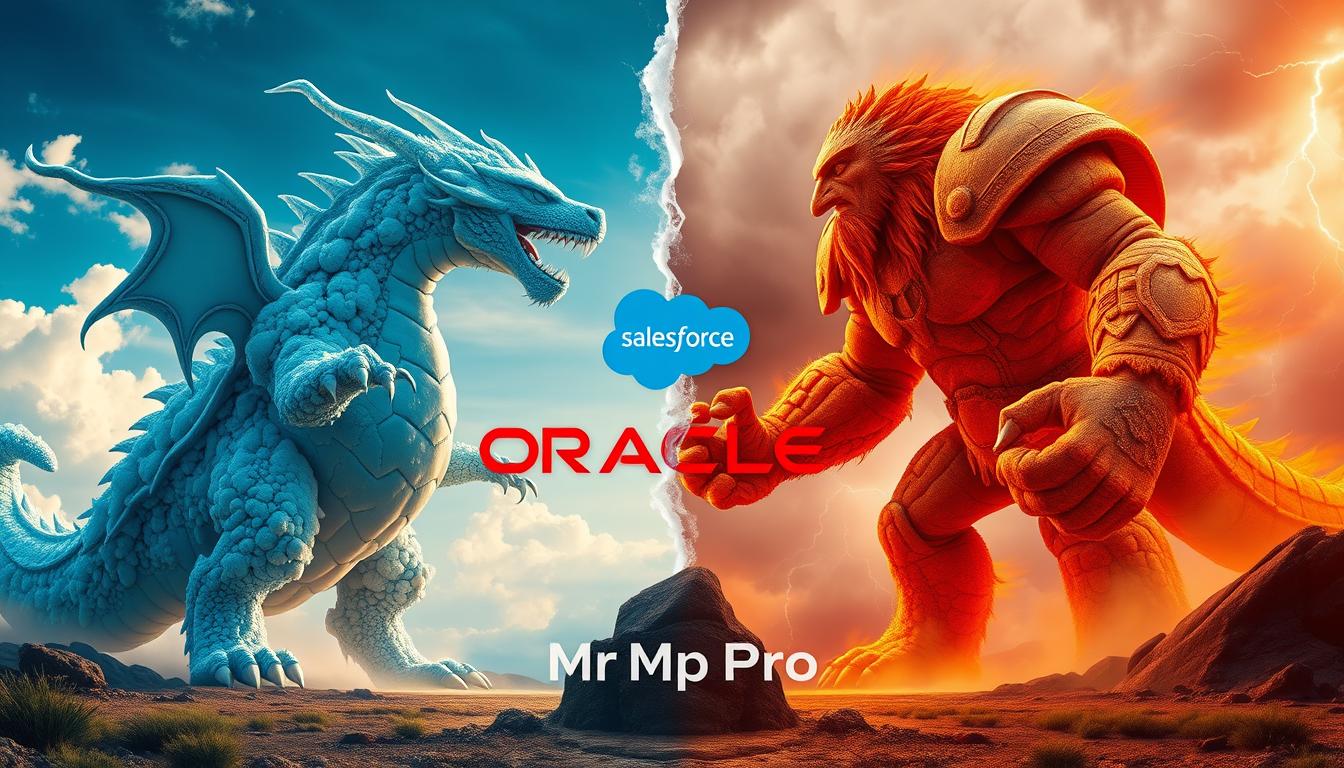
Did you know the HR software market is worth $10 billion a year? The financial app sales market is around $30 billion annually. Oracle and Salesforce are two tech giants fighting for dominance in this huge market. Their rivalry has greatly influenced the future of enterprise software, focusing on CRM.
The story starts with Larry Ellison’s Oracle, a leading company. Marc Benioff then created Salesforce, aiming to change the game with new approaches to CRM.
Cloud computing has been a major factor, allowing Salesforce to challenge Oracle’s long-standing lead. The IT market is growing fast, making the battle between these two even more intense. This competition is driving innovation and changing how businesses operate.
So, what’s next for Oracle and Salesforce? How will their rivalry continue to influence the world of enterprise software and CRM?
The Origins of a Tech Industry Rivalry
The story of Oracle and Salesforce starts with Larry Ellison and Marc Benioff. Ellison founded Oracle in 1977, quickly becoming a leader in enterprise software. Benioff worked at Oracle from 1986 to 1999 before starting Salesforce. He learned a lot about the industry and wanted to create a new kind of software company focused on cloud-based solutions.
Benioff’s time at Oracle helped shape his vision for salesforce crm and enterprise software differences. He saw the need for software that was more flexible and customer-focused. This became the core of Salesforce. Ellison’s Oracle, on the other hand, focused on traditional enterprise software.
The rivalry between Oracle and Salesforce started during Benioff’s time at Oracle. He gained valuable experience and insight, shaping his vision for Salesforce. This vision would change the enterprise software industry with cloud-based solutions and a focus on customers.
Larry Ellison’s Oracle Empire
Larry Ellison’s leadership and vision have made Oracle what it is today. Oracle focuses on oracle crm and traditional enterprise software. This has kept Oracle at the top of the industry.
Marc Benioff’s Early Days at Oracle
Marc Benioff’s time at Oracle was filled with growth and learning. He gained a deep understanding of the enterprise software industry. He started to think about a software company that would challenge the traditional ways.
The Seeds of Competition
The rivalry between Oracle and Salesforce started early. Benioff’s vision for cloud-based software challenged Oracle’s traditional solutions. This rivalry has shaped the enterprise software industry.
Marc Benioff’s Vision: Breaking Away from Oracle
Marc Benioff wanted to start a cloud-based software company. He aimed to offer customer relationship management (CRM) and sales force automation. This was different from Oracle, which focused on various software solutions but wasn’t cloud-based.
Benioff wanted Salesforce to be more agile and innovative than Oracle. He wanted solutions that fit the needs of businesses in the cloud era. Salesforce was more flexible and cost-effective, focusing on crm system features that were easy to use.
Some key features of Salesforce’s CRM system include:
- Cloud-based infrastructure
- Scalable and flexible pricing
- Easy to use and implement
Benioff aimed to offer solutions like CRM and sales force automation at a lower cost. Salesforce’s salesforce vs. oracle pricing and crm system features made it a strong competitor in the cloud market.
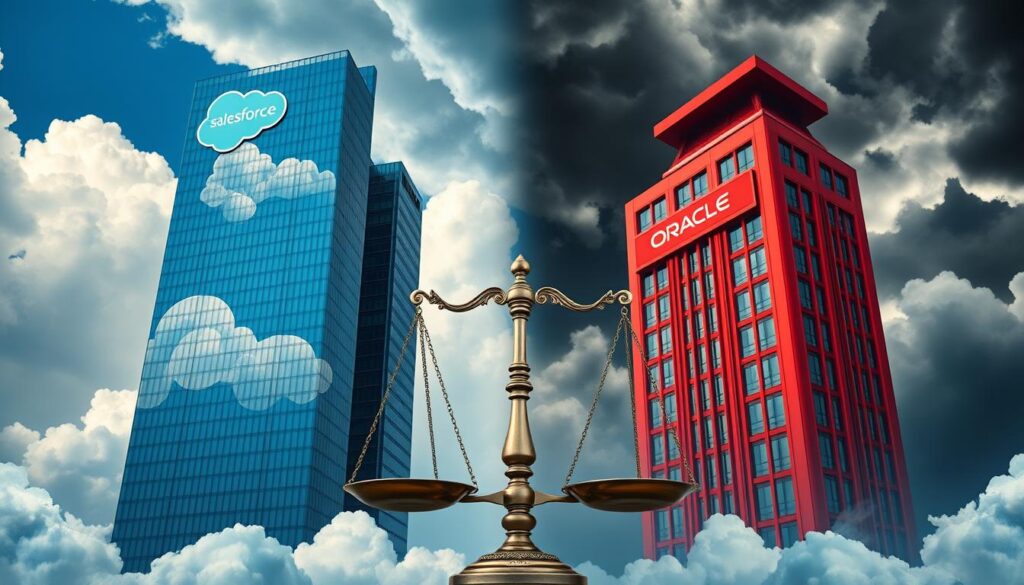
Today, Salesforce leads in cloud-based software solutions. It offers a range of crm system features and flexible pricing. This makes it appealing to businesses of all sizes.
| Company | Revenue | Growth Rate |
|---|---|---|
| Salesforce | $35 billion | 9% |
| Oracle | $50 billion | 5% |
The Birth of Salesforce and Cloud Computing Revolution
Exploring Salesforce’s history shows how it changed the traditional enterprise software world. Marc Benioff, a former Oracle manager, started Salesforce in 1999. He brought a “no software” idea, focusing on cloud-based solutions for businesses. This led to benefits like agility and innovation, and cost savings and scalability.
Early on, Salesforce’s success came from its innovative solutions. It offered CRM and sales force automation in a more agile way than traditional companies. As cloud-based solutions became more popular, Salesforce grew. It became a key player, attracting businesses of all sizes with its benefits.

Some key features of Salesforce’s approach include:
* Cloud-based solutions for businesses
* “No software” philosophy
* Agility and innovation in CRM and sales force automation
* Cost savings and scalability for businesses
Understanding Salesforce’s start and its impact on the industry helps us see the value of its advantages. These benefits are important in today’s business world.
| Year | Event | Impact |
|---|---|---|
| 1999 | Founding of Salesforce | Introduction of cloud-based solutions for businesses |
| 2004 | Initial public offerings | Raised $110 million, expanding Salesforce’s reach |
| 2009 | Surpassed $1 billion in annual revenue | Established Salesforce as a major player in the enterprise software industry |
Oracle vs. Salesforce: Direct Competition Begins
The enterprise software industry is changing fast. Oracle and Salesforce are now direct competitors, making it hard for businesses to choose. Both offer many tools for CRM software comparison.
BusinessWeek says the rivalry started in the early 2000s. Salesforce was growing, and Oracle saw it as a threat. So, Oracle began competing with Salesforce.
This competition has pushed both companies to innovate. They’ve developed new solutions and technologies. Both offer features like activity tracking, business intelligence, and sales forecasting. Here’s a table showing some of these features:
| Feature | Oracle CRM | Salesforce |
|---|---|---|
| Activity Dashboard | Yes | Yes |
| Activity Tracking | No | Yes |
| Business Intelligence | Yes | Yes |
| Sales Forecasting | Yes | Yes |
Choosing between Oracle and Salesforce depends on your business needs. Both offer many features and tools. Think about what your business needs most. This way, you can pick the right CRM software for you.

Cloud Computing: The Battlefield of Choice
When picking for your business, knowing the cloud computing market is key. Oracle and Salesforce have fought hard in this area. Oracle is catching up to Salesforce, the early leader.
The tech differences between them matter a lot. Salesforce offers cloud solutions that are quick and innovative. Oracle’s cloud revenue is mostly from SaaS, making up 74% of its cloud income. This is part of its $39 billion total revenue.
Here are some important stats to think about when looking at salesforce crm and oracle crm:
- Oracle’s SaaS business is growing fast, with an annualized run rate of $4.5 billion.
- Salesforce leads in the enterprise software market, with a strong spot in SaaS ERP.
- Oracle’s Data Cloud has over 5 billion IDs and 7.5 trillion data points. This helps its AI for better customer service.
Choosing between salesforce crm and oracle crm means looking at the enterprise software differences. Knowing the cloud market and the rivalry helps you pick wisely for your business.
The final decision between salesforce crm and oracle crm depends on your business needs. The enterprise software differences that matter to you will guide your choice.
| Company | SaaS Revenue | Annualized SaaS Run Rate |
|---|---|---|
| Oracle | $1.123 billion | $4.5 billion |
| Salesforce | Not disclosed | Not disclosed |
Business Model Evolution and Market Impact
Oracle and Salesforce have changed the game in enterprise software. Oracle used to sell software licenses, but Salesforce came up with a cloud-based subscription model. This new way of doing things is faster and more innovative.
This change has led to new ideas and technologies. It’s like a never-ending race to see who can come up with the next big thing.
Here are some key points about their business models:
- Oracle’s Autonomous Oracle Database Service aims to cut costs and improve performance, scalability, and security.
- Salesforce’s ecosystem, built on platforms like Force.com, and its Einstein AI layer, offer predictive analytics right in apps.
The oracle crm advantages and salesforce crm benefits have been key to their success. As the market keeps changing, these companies must keep innovating to stay on top.
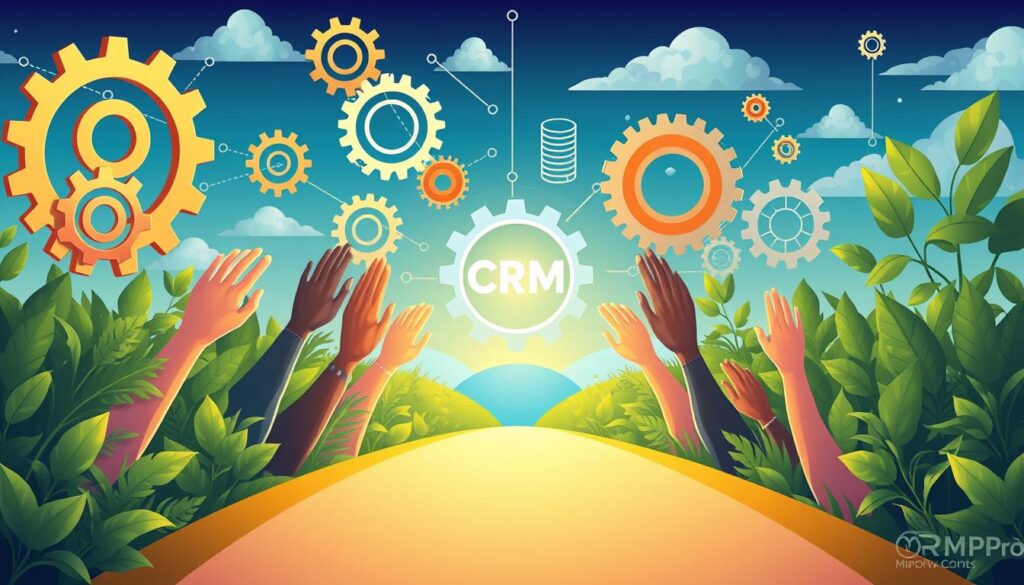
Their evolution has made a big splash in the market. Both Oracle and Salesforce are leaders in the enterprise software world. It will be exciting to see how they adapt and innovate in the future.
| Company | Business Model | Key Features |
|---|---|---|
| Oracle | Traditional software licensing | Autonomous Oracle Database Service |
| Salesforce | Cloud-based subscription | Einstein AI layer, Force.com |
Product Portfolio Face-off
Oracle and Salesforce both have a wide range of solutions for businesses. Salesforce is famous for its cloud-based CRM, which is agile and innovative. This makes it a top choice for managing customer relationships.
On the other hand, Oracle’s traditional software has faced challenges from Salesforce’s cloud offerings. The salesforce vs. oracle pricing is a key factor. Salesforce has different pricing tiers to fit various business needs. Here’s a comparison of their prices:
| Company | Pricing Tier | Price per User per Month |
|---|---|---|
| Salesforce | Essentials | $25 |
| Salesforce | Professional | $75 |
| Oracle | Basic | $75 |
| Oracle | Premium | $300 |
Choosing between Oracle and Salesforce depends on your business needs. Look at crm system features and salesforce vs. oracle pricing to make the best choice. This will help you pick the solution that supports your goals.
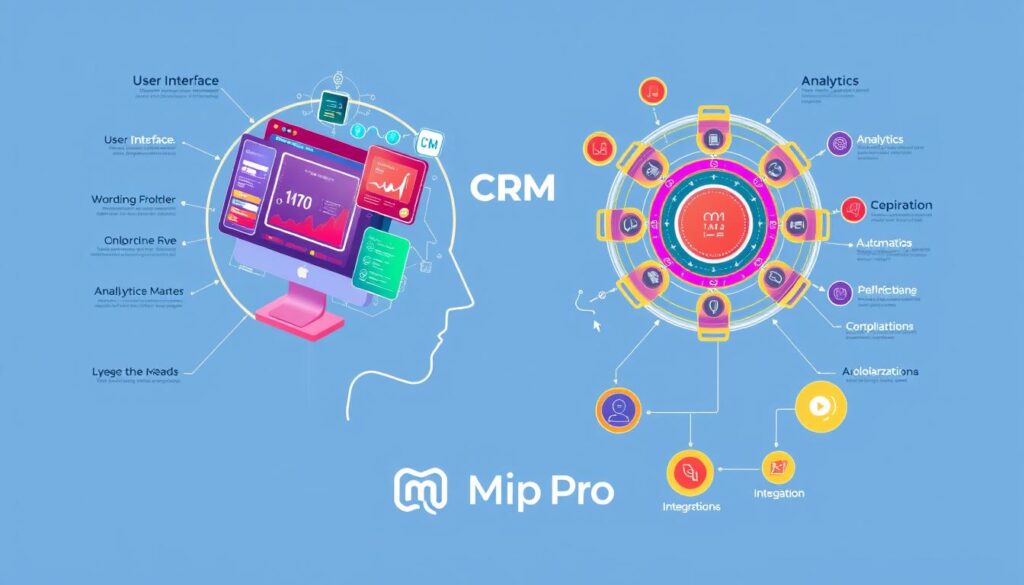
The Personal Vendetta Goes Public
The rivalry between Oracle and Salesforce is driven by a personal feud between Larry Ellison and Marc Benioff. This public fight has pushed innovation forward. It has led to new solutions and technologies in the crm software comparison market. Understanding this feud’s impact on the industry is key when looking at the oracle vs. salesforce debate.
Salesforce holds about 20% of the CRM software market as of 2023. Oracle’s CRM offerings grow at about 10% each year. The global CRM software market is expected to hit $80 billion by 2025.
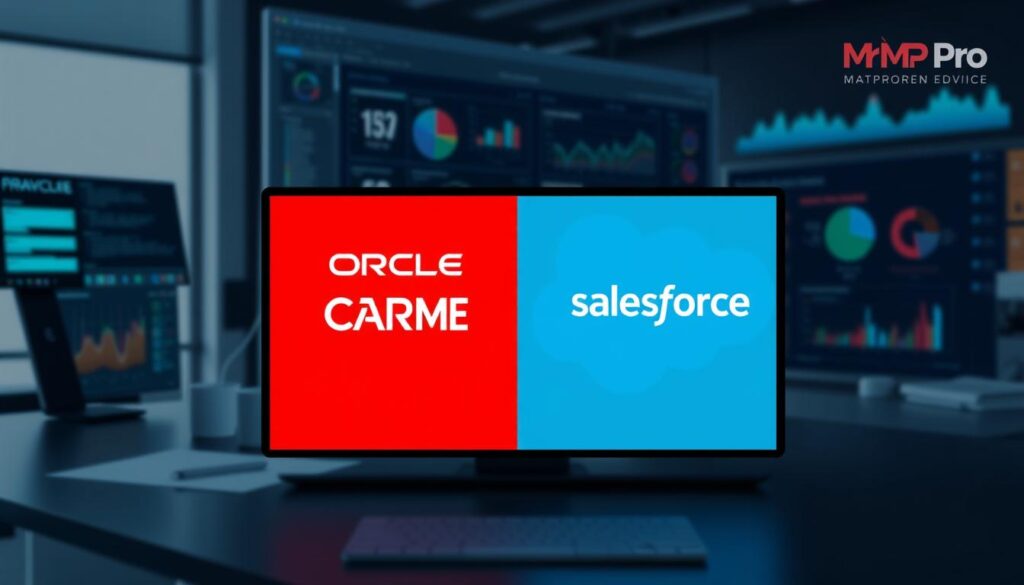
- Salesforce’s annual revenue was around $31 billion in 2023, showing a 25% growth from the year before.
- Oracle’s cloud application revenue was about $13 billion for the fiscal year 2023.
- Salesforce products have a customer satisfaction rate over 90%. Oracle’s solutions have a satisfaction rate of about 75%.
The feud between Larry Ellison and Marc Benioff has greatly influenced the competition between Oracle and Salesforce. When comparing crm software, remember the rivalry’s positive effects on the industry and customers.
According to BusinessWeek, the personal vendetta between Larry Ellison and Marc Benioff has been a significant factor in the competition between Oracle and Salesforce.
| Company | Market Share | Revenue Growth |
|---|---|---|
| Salesforce | 20% | 25% |
| Oracle | 10% | 10% |
Customer Experience and Market Reception
Oracle and Salesforce have their own strengths and weaknesses in customer experience and market reception. Oracle offers a complete view of customer interactions. Salesforce, on the other hand, provides cloud-based solutions that are agile and innovative.
The user interface is a key factor in customer experience. A good interface makes a big difference, with intuitive navigation and easy-to-use features being critical. Salesforce is known for its user-friendly interface, which customers appreciate.
Companies that focus on customer experience tend to grow faster. They can see revenue growth of 4%-8% above the market. This is because loyal customers become promoters, increasing a brand’s value significantly. So, it’s important for businesses to aim for a positive customer experience, considering both Oracle and Salesforce’s benefits.

- 89% of consumers have switched to a competitor after a poor customer experience
- Brands that provide a good customer experience generate 5.7x more revenue than competitors who fall short
- Customers who have a positive experience are 140% more likely to spend than those who have a poor experience
Innovation Race: Patents and Acquisitions
The battle between Oracle and Salesforce has fueled innovation in the enterprise software world. When you look at crm software comparison, the innovation race is key. BusinessWeek says this race has fueled their rivalry, with patent battles and acquisitions.
This has brought new solutions and technologies to the table. It benefits customers and grows the industry. The oracle vs. salesforce rivalry has made both companies invest in R&D. This has led to many innovative products and services.
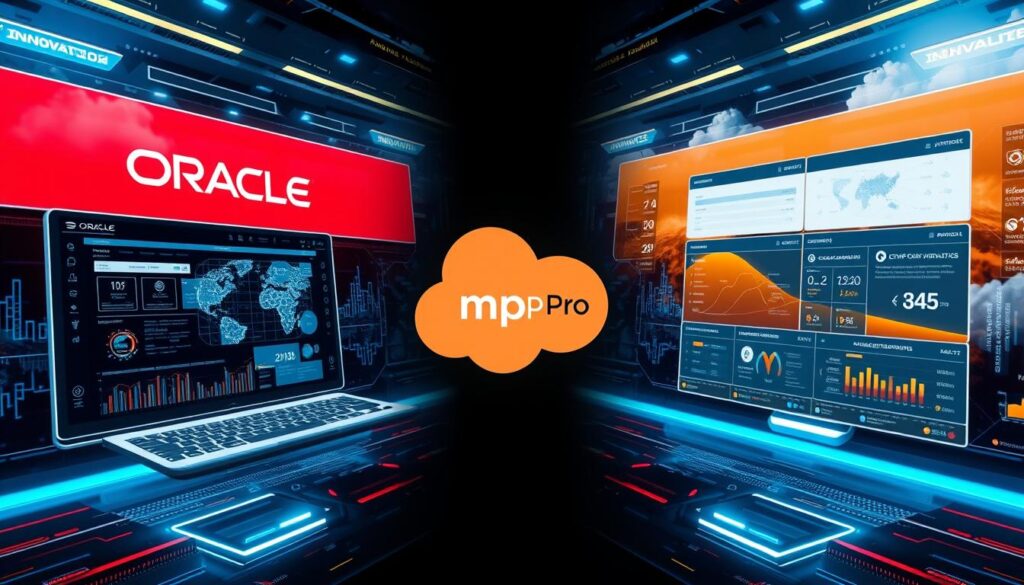
- Average patent citations for Salesforce: 64.68
- Oracle’s R&D Intensity: Not specified, but significant investments in innovation
- Citations per patent for Salesforce: 65
These numbers show both companies’ dedication to innovation. They work hard to lead in the crm software comparison market.
Global Market Share and Financial Performance
Oracle and Salesforce have both seen big growth in the global market. Salesforce’s cloud-based solutions offer agility and innovation. This has led to higher revenue and market value. In 2023, Salesforce made $34.9 billion in revenue and had a net profit of $4.1 billion.
Its revenue went up by 10% from the year before. Salesforce holds a 22% share of the CRM market, with over 150,000 customers. Oracle, on the other hand, has a 4.4% market share. Salesforce’s cloud solutions have helped it grow faster and more sustainably.
As of May 2024, Salesforce’s market capitalization is $263.52 billion. The company has made over 70 acquisitions, including Slack for $27.7 billion in 2021. Oracle aims to reach $104 billion in revenue by FY2029. The enterprise software differences between them show in their financial results. Salesforce’s solutions are driving growth and innovation in the industry.
Corporate Culture Clash
The rivalry between Oracle and Salesforce goes beyond just technology. It’s also about their corporate culture. As you look into their history of competition, you’ll see they have different business approaches. Oracle sticks to a traditional software licensing model, while Salesforce uses a cloud-based subscription model. Salesforce’s model is more agile and innovative.
Oracle’s CRM suite is a big plus for it. But Salesforce’s cloud model is more flexible and adaptable. The salesforce crm benefits include real-time updates and insights. This helps businesses make better decisions.
The clash in corporate culture between Oracle and Salesforce is key. Oracle focuses on acquiring and integrating new technologies. Salesforce, on the other hand, develops its own cloud-based solutions. This difference in approach has led to a clash of corporate cultures.
Some of the key differences between the two companies include:
- Different approaches to innovation
- Distinct corporate cultures
- Varying levels of agility and adaptability
In conclusion, the clash in corporate culture between Oracle and Salesforce has shaped their competition. When looking at the oracle crm advantages and salesforce crm benefits, consider their broader corporate cultures and innovation approaches.
Impact on Enterprise Software Industry
The battle between Oracle and Salesforce has changed the enterprise software world. Cloud computing has been a key area of focus for both companies. This has led to new solutions and technologies.
Now, the industry is moving towards more flexible and creative software. crm system features are becoming a major factor in choosing software.
The salesforce vs. oracle pricing debate has also played a big role. Both companies offer different pricing plans to meet various business needs. For example, Salesforce has four plans from $25 to $330/user/month. Oracle starts at $65/user/month and goes up to $300/user/month.
This competition has brought many benefits to the industry. It has led to more innovation and new technologies. The pricing has become more competitive, giving businesses more choices.
There’s also a greater focus on crm system features as a key differentiator. Overall, the rivalry between Oracle and Salesforce has deeply influenced the enterprise software industry. It has driven innovation and led to new solutions and technologies.
As the industry keeps evolving, it will be exciting to see how these companies continue to influence enterprise software.
Modern Day Dynamics and Competition
The battle between Oracle and Salesforce is heating up in the enterprise software world. Oracle’s Larry Ellison has taken shots at Salesforce’s cloud services. On the other hand, Marc Benioff has fired back, criticizing Oracle’s old-school software licensing.
The crm software comparison between Oracle and Salesforce is key. Both offer CRM, ERP, and cloud solutions. But they go about it differently. Oracle sticks to traditional licensing, while Salesforce pushes cloud-based options.
Recent reports show the oracle vs. salesforce rivalry is sparking innovation. Both are pouring money into R&D, focusing on AI and ML. This has led to new cloud CRM and AI-powered customer service tools.
When it comes to pricing, Salesforce starts at $25/user/month. Oracle’s prices vary by module and setup. This has sparked a crm software comparison, with customers weighing costs and benefits.
In summary, the ongoing competition between Oracle and Salesforce is influencing the enterprise software market. As the market changes, it will be fascinating to see how these giants adapt and innovate for their customers.
Conclusion: The Ongoing Battle for Enterprise Software Dominance
The fight between Oracle and Salesforce is exciting and has changed the software world. Oracle’s strengths in CRM have been known for a long time. But Salesforce’s cloud-based CRM has changed the game, making it a strong rival.
This rivalry shows how complex the software market is. Customers want solutions that are fast and cloud-based. Companies must keep up with these changes to stay ahead.
The winner will be the one that meets the needs of businesses best. They need to offer great functionality, growth, and user experience. With trends like AI and data analytics, Oracle and Salesforce will face big challenges. Their leadership could change the software world for many years.

 Oracle vs. Salesforce: A Tale of Rivalry and Revenge
Oracle vs. Salesforce: A Tale of Rivalry and Revenge
0 Comment